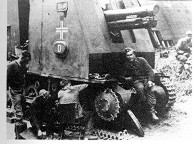Assault guns
A definition
![]()
![]()
Introduction:
The assault gun is a armored tracked vehicle designed essentially for infantry support in dense areas, such as thick woodlots, narrow passes, and streets; areas where it is easy for the opponent to organize a short range defense. To this effect, the assault gun retook the rôle of WW1's first ugly tanks: close infantry support. For this presentation, this is an entirely German concept, although the British, American, Russian and Italian armies adapted by some armies to fill immediate needs.
Origins:
When tank production was limited to a certain given number of machines, the German Army sought to increase its artillery mobility by procurement of near-ob solete tank chassis in order to motorize these tubes. The student had to bear in mind that German artillery was motsly tracted, even by the horse. Some artillery officers wanted short gun tubes in order to provide close range infantry support. Others wanted a longer tube to design a specialized armored chassis for destro ying tanks in a defensive posture. And some others wanted to have reguler field horwitzers fixed on these chassis for general artillery work in vehicles known as self propelled artillery pieces. As it came, Germany's first assault gun was used for a dual-rôle: field artillery and close range street buster for infantry assaults. Although it was a classic self-propelled artillery piece, the SDKF-6 pictured below, was the WW2 ancestor of assault guns to come. Assault gun criteria resemble that of a tank destroyer, except for its mobility: protection was paramount, but it had also to be more mobile and generally lighter than tank destroyers which are defensive weapons. The assault gun's criterias are: protection - mobility - arma ment. As the war dragged on, and that obsolete tank chassis are kept into produc tion, the German artillery lobby will insist for an increase in self propelled assault guns, better known as Sturmgeschutz or Stug in short. Assault guns cost much less than a regular battle tank, and take less man-hours to built; more could be produce for the same amount of time and components. To cut further costs, German industry even took armor, mantels and gun tubes from destroyed or captu red enemy tanks, such as the Russian T-34.
Use:

The SDKF-6 took part successfully to the first German campaigns of 1939-40. It was designed on the light obsolete PZKW-1 chassis. But in December 1939, the first of the Stug series of assault guns, the StuG-3, appeared. Designed with the al ready available PZKW-3 tank chassis, it had a lower profile because it had no tur ret, and was as easy to camouflage as difficult to hit by an enemy gunner. Like tank destroyers to come, this low profile had a detrimental effect on crew space, but it improve their armored protection. Crews had to share space with the gun and ammunition; the gun then in use was the short 75mm barrel of the PZKW-4 tank. The StuG-3 was used from 1940 onwards in every operational theaters. In the summer of 1942, better and more protected assault guns were introduced. The long-barrelled 75mm StuG-3B and the new StuH series with their stubby noi sy 105mm guns did excellent work in the Eastern front and Italy. Germany's most notorious and successful assault gun was the Hertzer or "baiter". It was de signed from the obsolete Czech TNH-38 tank chassis, which was widened with a thick angular anti-magnetic armor known as Zimmeritt, and fitted with captured Soviet 76.2mm tank guns. The Hertzer fought mostly in Italy and Western Euro pe. In Arnhem, it contributed to the rout of the British paratroopers in numerous Netherlands villages. Like its bigger brother, the SDKF-174 tank destroyer known as the Panzerjager 4, the Hertzer was a low and stubby well protected ve hicle. After the war, the assault gun was almost abandoned. The reason was the introduction of lighter and better infantry fighting vehicles and helicopters which could do its job of keeping pace with infantry assaults
_________________
Ó
JPA Sites, 1999